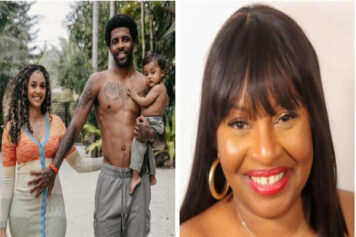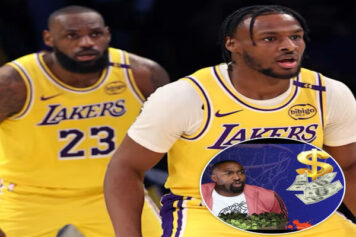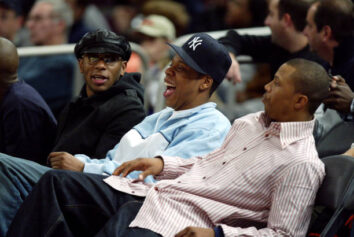While Black America debates whether or not we are “post” anything—black/bougie/modern/racial—what’s not up for discussion is whether or not we are post-ghetto. That answer is a resounding “HELL NO.” That debate isn’t even on the table, it’s not cooking in the kitchen, the groceries haven’t even been bought yet.
We’re six million miles from W.E.B. DuBois and the popularity of the “Talented Tenth” concept. The assertion that “the Negro race, like all races, is going to be saved by its ‘exceptional men’,” was shortsighted. It’s not reasonably possible that a nation of millions should be led by a contingent of well-heeled, moneyed folks (though considering how many people bow down to celebrity culture in this era, that kind of already happened, but let’s save that for another column).
Because DuBois promoted cognitive development over vocational skills, detractors like Booker T. Washington claimed that he was setting up African-Americans for generations of failure and a perpetual second-class citizenry. It wasn’t tangible; people argued that we aren’t gonna “out degree” mainstream America, so we had better learn how to fix the plumbing and install the air conditioners. But DuBois knew better and saw it as a way to lead the misguided out of small-mindedness and combine the cumulative resources of the Jim-Crow-dominated black communities of the early 20th Century. Creating a leadership class consisting of the best the community has to offer made sense, even if it wasn’t perfect.
The problem is, we basically did the opposite.
* * * * * * * * * *
One of the most unfortunate legacies of the Crack Era is that it conditioned two or three generations after it to honor the drug game. And more pointedly, to honor the best-case and worst-case scenarios brought forth from it. Young heads might not recall the ’80s (consider yourselves lucky), but it came with the force of a natural disaster. Reagonomics, AIDS and men wearing mascara were bad enough.Then Crack hit. It upheaved whole neighborhoods and took lives with no regard for culture or circumstance. And it went on for years. Imagine Hurricane Sandy dropping by once a month for eight years. Imagine raising kids in that environment. Imagine being a kid growing up in that situation. The scar tissue goes deep.
The era was full of terror and glamour. Terror being the callous loss of black life and the way addiction fractured the structure of poor and working class family units. The glamour came in the way that drug dealers started producing extreme materialism. People had been hustling forever, so that wasn’t new. And there were always a few guys jeweled up with mink coats, next level rides and pretty women on their arms. But not like this. Project kids were becoming overnight celebrities and hustlers became millionaires.
For young impressionable minds, even if it was known how they secured these goods, this was awe-inspiring. We all wanted a slice of the devil’s pie. How can anyone blame us? So ghetto culture, chock full of intoxicating tales of “they’ll never take me alive” and “ I gotta feed my kids” soliloquies of chaos, became the most regarded celebration of blackness. Even outside of the ghetto.
College kids who had never seen the inner city except via the words of Tom Brokaw, became enraptured by it. The popularity made anything that the hustlers valued (cars, clothes, women, music, basketball, etc.) trendy.
Basketball had already been a mainstay in inner-city communities for decades, but when the hood blew up, it took b-ball with it, and everything else: the slang, the clothes (baggy pants was originally a prison look) and the rep. Being from the streets became, in many circles, the ultimate example of your bonafides. Project guys with low SAT scores became the thing. He became a hero, or an anti-hero; either way, he was exalted. And the hood got the reupholster treatment.
College basketball specialized in recruiting these kinds of players, especially as guards. They were typically quick, steely and hungry. Guys like Stephon Marbury, Tim Hardaway and Allen Iverson became the standard. We shunned black guys from the ’burbs, said their styles weren’t rugged enough. We wanted dudes from the Southside of Chicago, Bed-Stuy, East Oakland, and West Baltimore. Players with nothing to lose. We wanted dudes who married this basketball sh*t; these suburb n*ggas were just engaged.
Shoe companies went through every athlete’s bio in a lustful search of a weed arrest or any sort of brush with the law. Magazines displayed black men with scowls and tats inside their pages and sold it as authenticity. This feeling had a name; they called it “street cred.”
It stayed that way for decades, but now, there are chinks in the armor. It’s changing, and now we’re on the verge of a paradigm shift. Why? Because the nastiest guard (not the best, but the “nastiest”) in the NBA is a prep school kid from the tony suburbs of Jersey who went to Duke.
* * * * * * * * * *
West Orange is a small city in Essex County, approximately a half-hour outside of New York City. To say it’s a normal suburb makes it sound too perfect. Too idyllic. We aren’t goin’ there. But numbers don’t lie, and man, the numbers associated with West Orange are amazing. The median household income is $88,884, the average price of a house is over $402,000, and in 2011, there was one reported murder. Kyrie Irving spent his freshman and sophomore years at nearby Montclair Kimberley Academy (before transferring to national power St. Patrick’s Academy, in Elizabeth). The tuition for ninth through twelfth graders at Montclair is $ 32,000 a year. They don’t have a principal; they have a headmaster. You get the point.
Kyrie’s father, Dred, played college ball at Boston University and after a stint playing overseas (Kyrie was born in Australia), came back to the states and began a career as a bond broker on Wall Street. Theirs was a life of good living (although sadly, Kyrie’s mother passed when he was four years old) and privilege, but Mr. Irving, knowing Kyrie needed to diversify his competition, made sure to trek him around inner-city courts around the Tri-State area.
Kyrie is Carlton Banks with a handle, but his game is littered with the accoutrements of a guy who played at the Rucker. There hasn’t been any backlash, at all, in regards to Irving’s story. Nobody’s calling him an Uncle Tom like they did to Grant Hill. Nobody is saying his style is fraudulent. At least not yet.
He’s not the first person to make this jump. In this regard, he’s a descendant of Kobe Bryant who made the jump from Philly’s Main Line uber-suburbs, but brought with him a style straight from the Sonny Hill League. The difference between Kobe’s mid-90s ascension and what’s going on with Kyrie today is that there’s an audience for this transformation. Remember, people hated on Kobe, said he was a poser, that he wasn’t “black enough” and all of those warped, slender descriptions that people create when someone’s behavior doesn’t fit into their assumed definition of black identity politics. As a community, we’ve lamented about these descriptions for years and held umpteen community outreach seminars hoping to unearth a way to change the direction.
Kyrie is as, if not more, polished a player as Kobe was at the same age (but he has much better shot.) It’s the flair he plays with that makes him stand out. Right now, he’s picked up the baton from Brandon Jennings and Chris Paul––he has the sickest handle in the NBA . It’s beyond filthy. During last weekend’s All-Star festivities, he turned himself into a household name. Casual fans are now aware and his bandwagon, which was steadily adding new passengers, will become standing-room only. They saw him break Brandon Knight’s tibia bone on Friday and caught him stuntin’ in the All-Star on Sunday.
Undoubtedly, someone will discover that he’s not cut from the same cloth as everyone else. Will they assail him because he didn’t grow up on W.I.C.? If they do, they’ll have to go after a bunch of other guys, too.
A couple of years ago, a friend of mine said the problem with the NBA is there are too many middle-class ballplayers. But that hardly matters. There have always been guys from “circles” and “lanes,” even while it was the dudes from “avenues” and “streets” who controlled the narrative. But in recent years, we’ve seen a change from that type of glorification. Players like Steph Curry, Blake Griffin and Chris Paul didn’t come up from some hardscrabble existence. They grew up with their fathers around and never had to skip any meals. To my knowledge, they’ve never had their ghetto pass revoked because, frankly, they never needed it anyway. These guys are amongst the most popular players in the game and nobody gives a crap about their credibility. For years, guys from nice neighborhoods had to feel ashamed, some even hid this fact and created fake scenarios filled with rats and roaches. The fallacy of associating black male authenticity with inner-city blues is a trap for suckers and punks. Basketball has seemingly turned the page on this mentality. If only mainstream hip-hop could do the same.
Kyrie’s success will be the latest test. If he can come out of this unscathed, then we might be on to something great. If the crabs drag him back down into their bucket, then it’s more proof that we haven’t yet learned from our mistakes. The inner-city isn’t a place to be embarrassed about, it’s a geographical construct. The mistake is allowing it to become a mental construct, where we somehow punish players who don’t have that history. Finally, that seems to be changing. Used to be that we only wanted players with a certain kind of story, but now, we accept them without the hardship background as an attachment. We’re getting away from penalizing guys and assuming they are soft because they come from money. This archaic notion is on the way out. This deserves a slow clap, so let’s give ’em one.



